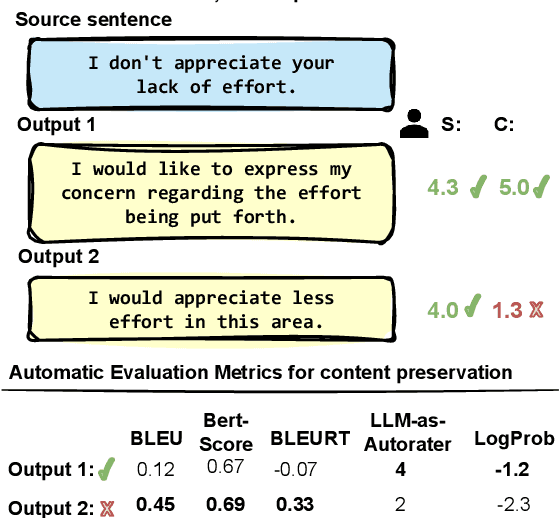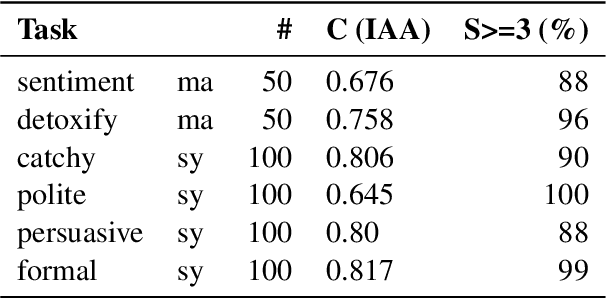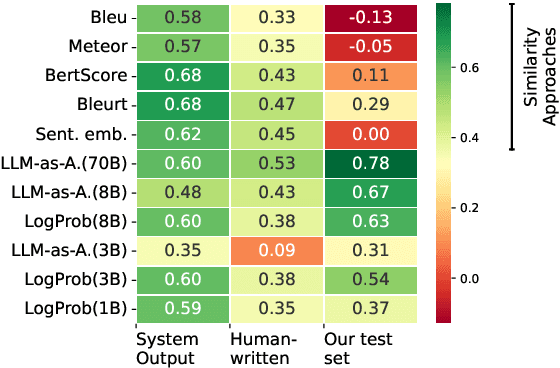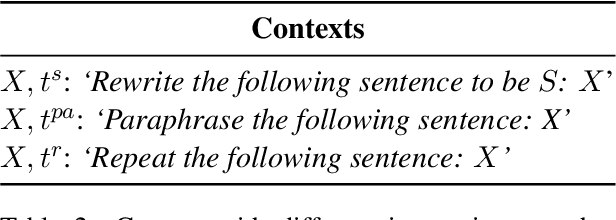Isabelle Augenstein
Entangled in Representations: Mechanistic Investigation of Cultural Biases in Large Language Models
Aug 12, 2025Abstract:The growing deployment of large language models (LLMs) across diverse cultural contexts necessitates a better understanding of how the overgeneralization of less documented cultures within LLMs' representations impacts their cultural understanding. Prior work only performs extrinsic evaluation of LLMs' cultural competence, without accounting for how LLMs' internal mechanisms lead to cultural (mis)representation. To bridge this gap, we propose Culturescope, the first mechanistic interpretability-based method that probes the internal representations of LLMs to elicit the underlying cultural knowledge space. CultureScope utilizes a patching method to extract the cultural knowledge. We introduce a cultural flattening score as a measure of the intrinsic cultural biases. Additionally, we study how LLMs internalize Western-dominance bias and cultural flattening, which allows us to trace how cultural biases emerge within LLMs. Our experimental results reveal that LLMs encode Western-dominance bias and cultural flattening in their cultural knowledge space. We find that low-resource cultures are less susceptible to cultural biases, likely due to their limited training resources. Our work provides a foundation for future research on mitigating cultural biases and enhancing LLMs' cultural understanding. Our codes and data used for experiments are publicly available.
BiasGym: Fantastic Biases and How to Find (and Remove) Them
Aug 12, 2025Abstract:Understanding biases and stereotypes encoded in the weights of Large Language Models (LLMs) is crucial for developing effective mitigation strategies. Biased behaviour is often subtle and non-trivial to isolate, even when deliberately elicited, making systematic analysis and debiasing particularly challenging. To address this, we introduce BiasGym, a simple, cost-effective, and generalizable framework for reliably injecting, analyzing, and mitigating conceptual associations within LLMs. BiasGym consists of two components: BiasInject, which injects specific biases into the model via token-based fine-tuning while keeping the model frozen, and BiasScope, which leverages these injected signals to identify and steer the components responsible for biased behavior. Our method enables consistent bias elicitation for mechanistic analysis, supports targeted debiasing without degrading performance on downstream tasks, and generalizes to biases unseen during training. We demonstrate the effectiveness of BiasGym in reducing real-world stereotypes (e.g., people from a country being `reckless drivers') and in probing fictional associations (e.g., people from a country having `blue skin'), showing its utility for both safety interventions and interpretability research.
Community Moderation and the New Epistemology of Fact Checking on Social Media
May 26, 2025Abstract:Social media platforms have traditionally relied on internal moderation teams and partnerships with independent fact-checking organizations to identify and flag misleading content. Recently, however, platforms including X (formerly Twitter) and Meta have shifted towards community-driven content moderation by launching their own versions of crowd-sourced fact-checking -- Community Notes. If effectively scaled and governed, such crowd-checking initiatives have the potential to combat misinformation with increased scale and speed as successfully as community-driven efforts once did with spam. Nevertheless, general content moderation, especially for misinformation, is inherently more complex. Public perceptions of truth are often shaped by personal biases, political leanings, and cultural contexts, complicating consensus on what constitutes misleading content. This suggests that community efforts, while valuable, cannot replace the indispensable role of professional fact-checkers. Here we systemically examine the current approaches to misinformation detection across major platforms, explore the emerging role of community-driven moderation, and critically evaluate both the promises and challenges of crowd-checking at scale.
Explaining Sources of Uncertainty in Automated Fact-Checking
May 23, 2025Abstract:Understanding sources of a model's uncertainty regarding its predictions is crucial for effective human-AI collaboration. Prior work proposes using numerical uncertainty or hedges ("I'm not sure, but ..."), which do not explain uncertainty that arises from conflicting evidence, leaving users unable to resolve disagreements or rely on the output. We introduce CLUE (Conflict-and-Agreement-aware Language-model Uncertainty Explanations), the first framework to generate natural language explanations of model uncertainty by (i) identifying relationships between spans of text that expose claim-evidence or inter-evidence conflicts and agreements that drive the model's predictive uncertainty in an unsupervised way, and (ii) generating explanations via prompting and attention steering that verbalize these critical interactions. Across three language models and two fact-checking datasets, we show that CLUE produces explanations that are more faithful to the model's uncertainty and more consistent with fact-checking decisions than prompting for uncertainty explanations without span-interaction guidance. Human evaluators judge our explanations to be more helpful, more informative, less redundant, and more logically consistent with the input than this baseline. CLUE requires no fine-tuning or architectural changes, making it plug-and-play for any white-box language model. By explicitly linking uncertainty to evidence conflicts, it offers practical support for fact-checking and generalises readily to other tasks that require reasoning over complex information.
CUB: Benchmarking Context Utilisation Techniques for Language Models
May 22, 2025Abstract:Incorporating external knowledge is crucial for knowledge-intensive tasks, such as question answering and fact checking. However, language models (LMs) may ignore relevant information that contradicts outdated parametric memory or be distracted by irrelevant contexts. While many context utilisation manipulation techniques (CMTs) that encourage or suppress context utilisation have recently been proposed to alleviate these issues, few have seen systematic comparison. In this paper, we develop CUB (Context Utilisation Benchmark) to help practitioners within retrieval-augmented generation (RAG) identify the best CMT for their needs. CUB allows for rigorous testing on three distinct context types, observed to capture key challenges in realistic context utilisation scenarios. With this benchmark, we evaluate seven state-of-the-art methods, representative of the main categories of CMTs, across three diverse datasets and tasks, applied to nine LMs. Our results show that most of the existing CMTs struggle to handle the full set of types of contexts that may be encountered in real-world retrieval-augmented scenarios. Moreover, we find that many CMTs display an inflated performance on simple synthesised datasets, compared to more realistic datasets with naturally occurring samples. Altogether, our results show the need for holistic tests of CMTs and the development of CMTs that can handle multiple context types.
Multi-Modal Framing Analysis of News
Mar 26, 2025



Abstract:Automated frame analysis of political communication is a popular task in computational social science that is used to study how authors select aspects of a topic to frame its reception. So far, such studies have been narrow, in that they use a fixed set of pre-defined frames and focus only on the text, ignoring the visual contexts in which those texts appear. Especially for framing in the news, this leaves out valuable information about editorial choices, which include not just the written article but also accompanying photographs. To overcome such limitations, we present a method for conducting multi-modal, multi-label framing analysis at scale using large (vision-)language models. Grounding our work in framing theory, we extract latent meaning embedded in images used to convey a certain point and contrast that to the text by comparing the respective frames used. We also identify highly partisan framing of topics with issue-specific frame analysis found in prior qualitative work. We demonstrate a method for doing scalable integrative framing analysis of both text and image in news, providing a more complete picture for understanding media bias.
Unstructured Evidence Attribution for Long Context Query Focused Summarization
Feb 20, 2025Abstract:Large language models (LLMs) are capable of generating coherent summaries from very long contexts given a user query. Extracting and properly citing evidence spans could help improve the transparency and reliability of these summaries. At the same time, LLMs suffer from positional biases in terms of which information they understand and attend to, which could affect evidence citation. Whereas previous work has focused on evidence citation with predefined levels of granularity (e.g. sentence, paragraph, document, etc.), we propose the task of long-context query focused summarization with unstructured evidence citation. We show how existing systems struggle to generate and properly cite unstructured evidence from their context, and that evidence tends to be "lost-in-the-middle". To help mitigate this, we create the Summaries with Unstructured Evidence Text dataset (SUnsET), a synthetic dataset generated using a novel domain-agnostic pipeline which can be used as supervision to adapt LLMs to this task. We demonstrate across 5 LLMs of different sizes and 4 datasets with varying document types and lengths that LLMs adapted with SUnsET data generate more relevant and factually consistent evidence than their base models, extract evidence from more diverse locations in their context, and can generate more relevant and consistent summaries.
A Meta-Evaluation of Style and Attribute Transfer Metrics
Feb 20, 2025



Abstract:LLMs make it easy to rewrite text in any style, be it more polite, persuasive, or more positive. We present a large-scale study of evaluation metrics for style and attribute transfer with a focus on content preservation; meaning content not attributed to the style shift is preserved. The de facto evaluation approach uses lexical or semantic similarity metrics often between source sentences and rewrites. While these metrics are not designed to distinguish between style or content differences, empirical meta-evaluation shows a reasonable correlation to human judgment. In fact, recent works find that LLMs prompted as evaluators are only comparable to semantic similarity metrics, even though intuitively, the LLM approach should better fit the task. To investigate this discrepancy, we benchmark 8 metrics for evaluating content preservation on existing datasets and additionally construct a new test set that better aligns with the meta-evaluation aim. Indeed, we then find that the empirical conclusion aligns with the intuition: content preservation metrics for style/attribute transfer must be conditional on the style shift. To support this, we propose a new efficient zero-shot evaluation method using the likelihood of the next token. We hope our meta-evaluation can foster more research on evaluating content preservation metrics, and also to ensure fair evaluation of methods for conducting style transfer.
Can Community Notes Replace Professional Fact-Checkers?
Feb 19, 2025Abstract:Two commonly-employed strategies to combat the rise of misinformation on social media are (i) fact-checking by professional organisations and (ii) community moderation by platform users. Policy changes by Twitter/X and, more recently, Meta, signal a shift away from partnerships with fact-checking organisations and towards an increased reliance on crowdsourced community notes. However, the extent and nature of dependencies between fact-checking and helpful community notes remain unclear. To address these questions, we use language models to annotate a large corpus of Twitter/X community notes with attributes such as topic, cited sources, and whether they refute claims tied to broader misinformation narratives. Our analysis reveals that community notes cite fact-checking sources up to five times more than previously reported. Fact-checking is especially crucial for notes on posts linked to broader narratives, which are twice as likely to reference fact-checking sources compared to other sources. In conclusion, our results show that successful community moderation heavily relies on professional fact-checking.
Presumed Cultural Identity: How Names Shape LLM Responses
Feb 17, 2025Abstract:Names are deeply tied to human identity. They can serve as markers of individuality, cultural heritage, and personal history. However, using names as a core indicator of identity can lead to over-simplification of complex identities. When interacting with LLMs, user names are an important point of information for personalisation. Names can enter chatbot conversations through direct user input (requested by chatbots), as part of task contexts such as CV reviews, or as built-in memory features that store user information for personalisation. We study biases associated with names by measuring cultural presumptions in the responses generated by LLMs when presented with common suggestion-seeking queries, which might involve making assumptions about the user. Our analyses demonstrate strong assumptions about cultural identity associated with names present in LLM generations across multiple cultures. Our work has implications for designing more nuanced personalisation systems that avoid reinforcing stereotypes while maintaining meaningful customisation.
 Add to Chrome
Add to Chrome Add to Firefox
Add to Firefox Add to Edge
Add to Edge